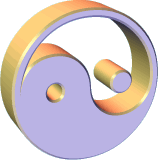









|
The
Chinese characters for Tai Chi Chuan can be translated as the
'Supreme Ultimate Force'. The notion of 'supreme ultimate' is often
associated with the Chinese concept of yin-yang, the notion that one can see
a dynamic duality (male/female, active/passive, dark/light,
forceful/yielding, etc.) in all things. 'Force' (or, more literally, 'fist')
can be thought of here as the means or way of achieving this ying-yang, or
'supreme-ultimate' discipline.

Tai Chi, as it is practiced in the west today, can perhaps best be
thought of as a moving form of yoga and meditation combined. There are a
number of so- called forms (sometimes also called 'sets') which
consist of a sequence of movements. Many of these movements are originally
derived from the martial arts (and perhaps even more ancestrally than that,
from the natural movements of animals and birds) although the way they are
performed in Tai Chi is slowly, softly and gracefully with smooth and even
transitions between them.
For many practicioners the focus in doing them is not, first and
foremost, martial, but as a meditative exercise for the body. For others the
combat aspects of Tai Chi are of considerable interest. In Chinese
philosophy and medicine there exists the concept of 'chi', a vital force
that animates the body. One of the avowed aims of Tai Chi is to foster the
circulation of this 'chi' within the body, the belief being that by doing so
the health and vitality of the person are enhanced. This 'chi' circulates in
patterns that are close related to the nervous and vascular system and thus
the notion is closely connected with that of the practice of acupuncture and
other oriental healing arts.
Another aim of Tai Chi is to foster a calm and tranquil mind, focused on
the precise execution of these exercises. Learning to do them correctly
provides a practical avenue for learning about such things as balance,
alignment, fine-scale motor control, rhythm of movement, the genesis of
movement from the body's vital center, and so on. Thus the practice of Tai
Chi can in some measure contribute to being able to better stand, walk,
move, run, etc. in other spheres of life as well. Many practitioners notice
benefits in terms of correcting poor postural, alignment or movement
patterns which can contribute to tension or injury. Furthermore the
meditative nature of the exercises is calming and relaxing in and of itself.
Because the Tai Chi movements have their origins in the martial arts,
practicing them does have some martial applications. In a two-person
exercise called 'push-hands' Tai Chi principles are developed in terms of
being sensitive to and responsive of another person's 'chi' or vital energy.
It is also an opportunity to employ some of the martial aspects of Tai Chi
in a kind of slow-tempo combat. Long-time practitioners of Tai Chi who are
so-inclined can become very adept at martial arts. The emphasis in Tai Chi
is on being able to channel potentially destructive energy (in the form of a
kick or a punch) away from one in a manner that will dissipate the energy or
send it in a direction where it is no longer a danger.
The practical exercises of Tai Chi are also situated in a wider
philosophical context of Taoism. This is a reflective, mystical Chinese
tradition first associated with the scholar and mystic Lao Tsu, an older
contemporary of Confucius. He wrote and taught in the province of Honan in
the 6th century B.C. and authored the seminal work of Taoism, the Tao Te
Ching. As a philosophy, Taoism has many elements but fundamentally it
espouses a calm, reflective and mystic view of the world steeped in the
beauty and tranquillity of nature.
Tai Chi also has, particularly amongst eastern practitioners, a long
connection with the I Ching a Chinese system of divination. There are
associations between the 8 basic I Ching trigrams plus the five elements of
Chinese alchemy (metal, wood, fire, water and earth) with the thirteen basic
postures of Tai Chi created by Chang San-feng. There are also other
associations with the full 64 trigrams of the I Ching and other movements in
the Tai Chi form.
|

